Thư viện tài liệu, ebook tổng hợp lớn nhất Việt Nam
Website chia sẻ tài liệu, ebook tham khảo cho các bạn học sinh, sinh viên

 Bài giảng An toàn thông tin - Chương 1 Những vấn đề cơ bản về an toàn thông tin
Bài giảng An toàn thông tin - Chương 1 Những vấn đề cơ bản về an toàn thông tinNhững nơi dễ bị tấn công • Sử dụng username và password • Giao thức TCP/IP • Các phần mềm có giao diện đồ họa, dễ dàng cấu hình -> nảy sinh vấn đề bảo mật • Email cho phép đính kèm các file thực thi.
 77 trang | Chia sẻ: vutrong32 | Ngày: 17/10/2018 | Lượt xem: 1002 | Lượt tải: 0
77 trang | Chia sẻ: vutrong32 | Ngày: 17/10/2018 | Lượt xem: 1002 | Lượt tải: 0 Chữ ký số tập thể - Mô hình và thuật toán
Chữ ký số tập thể - Mô hình và thuật toánBài báo đề xuất một mô hình ứng dụng chữ ký số gọi là mô hình chữ ký tập thể và lược đồ chữ ký số theo mô hình ứng dụng này có thể áp dụng cho đối tượng là các cơ quan, đơn vị, doanh nghiệp,. nhằm đảm bảo cho việc chứng thực các thông điệp dữ liệu trong các thủ tục hành chính điện tử hoàn toàn phù hợp với các thủ tục hành chính trong thực tế xã ...
 6 trang | Chia sẻ: vutrong32 | Ngày: 17/10/2018 | Lượt xem: 988 | Lượt tải: 0
6 trang | Chia sẻ: vutrong32 | Ngày: 17/10/2018 | Lượt xem: 988 | Lượt tải: 0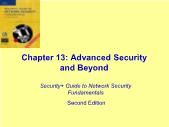 Bài giảng Security+ Guide to Network Security Fundamentals - Chapter 13: Advanced Security and Beyond
Bài giảng Security+ Guide to Network Security Fundamentals - Chapter 13: Advanced Security and BeyondSummary • Forensic science is application of science to questions of interest to the legal profession • Several unique opportunities give computer forensics the ability to uncover evidence that would be extremely difficult to find using a manual process • Computer forensics also has a unique set of challenges that are not found in standard e...
 27 trang | Chia sẻ: vutrong32 | Ngày: 17/10/2018 | Lượt xem: 973 | Lượt tải: 0
27 trang | Chia sẻ: vutrong32 | Ngày: 17/10/2018 | Lượt xem: 973 | Lượt tải: 0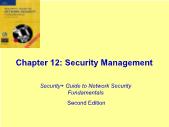 Bài giảng Security+ Guide to Network Security Fundamentals - Chapter 12: Security Management
Bài giảng Security+ Guide to Network Security Fundamentals - Chapter 12: Security ManagementSummary • Identity management provides a framework in which a single authenticated ID is shared across multiple networks or online businesses • Privilege management attempts to simplify assigning and revoking access control to users • Change management refers to a methodology for making and keeping track of changes
 38 trang | Chia sẻ: vutrong32 | Ngày: 17/10/2018 | Lượt xem: 974 | Lượt tải: 0
38 trang | Chia sẻ: vutrong32 | Ngày: 17/10/2018 | Lượt xem: 974 | Lượt tải: 0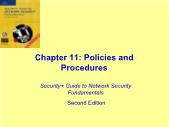 Bài giảng Security+ Guide to Network Security Fundamentals - Chapter 11: Policies and Procedures
Bài giảng Security+ Guide to Network Security Fundamentals - Chapter 11: Policies and ProceduresSummary • The security policy cycle defines the overall process for developing a security policy • There are four steps in risk identification: – Inventory the assets and their attributes – Determine what threats exist against the assets and by which threat agents – Determine whether vulnerabilities exist that can be exploited by surveying ...
 43 trang | Chia sẻ: vutrong32 | Ngày: 17/10/2018 | Lượt xem: 1151 | Lượt tải: 0
43 trang | Chia sẻ: vutrong32 | Ngày: 17/10/2018 | Lượt xem: 1151 | Lượt tải: 0 Bài giảng Security+ Guide to Network Security Fundamentals - Chapter 10: Operational Security
Bài giảng Security+ Guide to Network Security Fundamentals - Chapter 10: Operational SecuritySummary • Adequate physical security is one of the first lines of defense against attacks • Physical security involves restricting with access controls, minimizing social engineering attacks, and securing the environment and infrastructure • Business continuity is the process of assessing risks and developing a management strategy to ensure th...
 37 trang | Chia sẻ: vutrong32 | Ngày: 16/10/2018 | Lượt xem: 961 | Lượt tải: 0
37 trang | Chia sẻ: vutrong32 | Ngày: 16/10/2018 | Lượt xem: 961 | Lượt tải: 0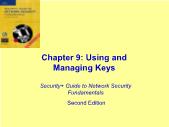 Bài giảng Security+ Guide to Network Security Fundamentals - Chapter 9: Using and Managing Keys
Bài giảng Security+ Guide to Network Security Fundamentals - Chapter 9: Using and Managing KeysSummary • One of the advantages of symmetric cryptography is that encryption and decryption using a private key is usually fast and easy to implement • A digital signature solves the problem of authenticating the sender when using asymmetric cryptography • With the number of different tools required for asymmetric cryptography, an organization ...
 34 trang | Chia sẻ: vutrong32 | Ngày: 16/10/2018 | Lượt xem: 965 | Lượt tải: 0
34 trang | Chia sẻ: vutrong32 | Ngày: 16/10/2018 | Lượt xem: 965 | Lượt tải: 0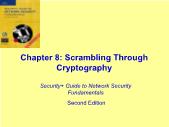 Bài giảng Security+ Guide to Network Security Fundamentals - Chapter 8: Scrambling Through Cryptography
Bài giảng Security+ Guide to Network Security Fundamentals - Chapter 8: Scrambling Through CryptographySummary • Cryptography seeks to fulfill five key security functions: confidentiality, authentication, integrity, nonrepudiation, and access control • Hashing, also called a one-way hash, creates a ciphertext from plaintext • Symmetric encryption algorithms use a single key to encrypt and decrypt a message
 46 trang | Chia sẻ: vutrong32 | Ngày: 16/10/2018 | Lượt xem: 1013 | Lượt tải: 0
46 trang | Chia sẻ: vutrong32 | Ngày: 16/10/2018 | Lượt xem: 1013 | Lượt tải: 0 Bài giảng Security+ Guide to Network Security Fundamentals - Chapter 7: Protecting Advanced Communications
Bài giảng Security+ Guide to Network Security Fundamentals - Chapter 7: Protecting Advanced CommunicationsSummary • The FTP protocol has several security vulnerabilities—it does not natively use encryption and is vulnerable to man-in-the-middle attacks • FTP can be hardened by using secure FTP (which encrypts using SSL) • Protecting remote access transmissions is particularly important in today’s environment as more users turn to the Internet as t...
 54 trang | Chia sẻ: vutrong32 | Ngày: 16/10/2018 | Lượt xem: 1010 | Lượt tải: 0
54 trang | Chia sẻ: vutrong32 | Ngày: 16/10/2018 | Lượt xem: 1010 | Lượt tải: 0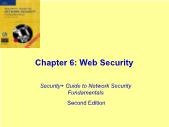 Bài giảng Security+ Guide to Network Security Fundamentals - Chapter 6: Web Security
Bài giảng Security+ Guide to Network Security Fundamentals - Chapter 6: Web SecuritySummary • Protecting basic communication systems is a key to resisting attacks • E-mail attacks can be malware, spam, or hoaxes • Web vulnerabilities can open systems up to a variety of attacks • A Java applet is a separate program stored on the Web server and downloaded onto the user’s computer along with the HTML code
 48 trang | Chia sẻ: vutrong32 | Ngày: 16/10/2018 | Lượt xem: 993 | Lượt tải: 0
48 trang | Chia sẻ: vutrong32 | Ngày: 16/10/2018 | Lượt xem: 993 | Lượt tải: 0

